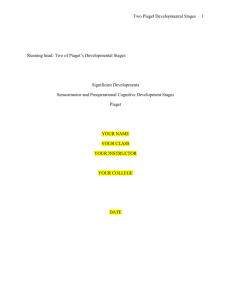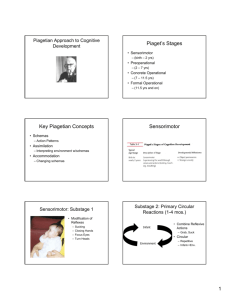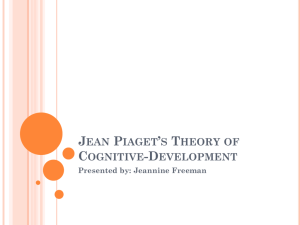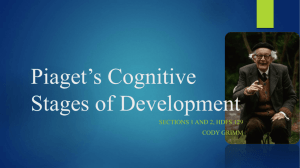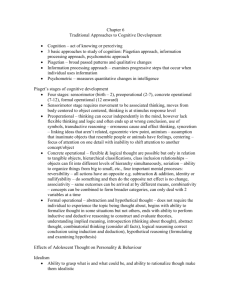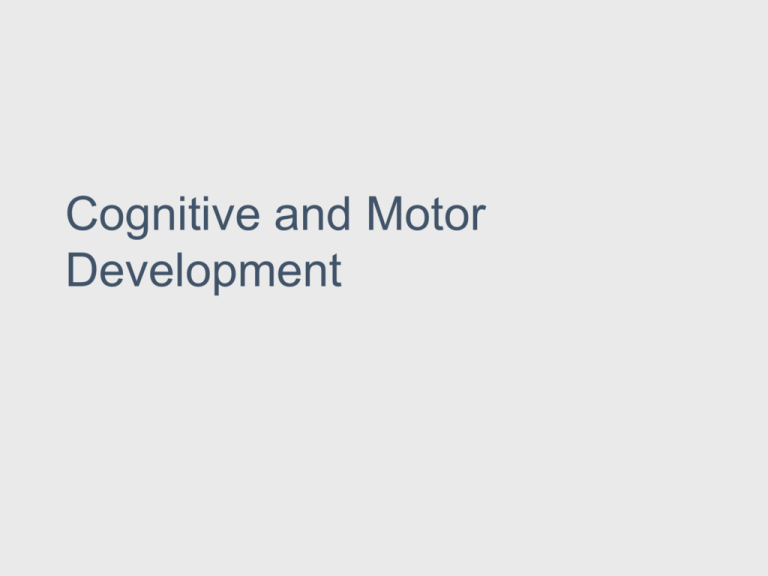
Cognitive and Motor
Development
There is a strong relationship
between human intellectual
function and movement:
Any intellectual change is
also accompanied by a
change
in motor function
Four Domains
• Affective
• Cognitive
• Motor
• Physical
Why organize into domains?
Interaction
The mind (psych) and human movement (motor) are related
Cognitive
Development
Motor
Development
Psychomotor or Motor?
• Motor
– Refers to any form of human movement
behavior
• Reflex movement
• Psychomotor
• Psychomotor
– Movements initiated by an electrical
impulse from higher brain centers
How does our gradually changing motor
ability affect our cognitive development?
How does our evolving cognitive
development affect our motor
development?
Cognitive Development
• Jean Piaget
– Swiss psychologist
– Interested in the
process of thinking
– Established the
clinical method of
research
1896-1980
"Piaget, Jean," Microsoft® Encarta® Online Encyclopedia 2001
http://encarta.msn.com © 1997-2001 Microsoft Corporation. All rights
reserved.
• Collected data during
question-and-answer
sessions
Cognitive Development
• Piaget’s Theory
– Four major stages of cognitive development
• Sensorimotor
• Preoperational
• Concrete operational
• Formal operational
• Interaction of cognitive and motor
development is found in Piaget’s Theory
Stages of Piaget’s Theory
Stage
Sensorimotor
Age/Period of
Occurrence
Birth to 2 years
Preoperational
2 to 7 years
Concrete
operational
7 to 11 years
Formal operational
Early to mid-adolescence
11 to 12 years
Piaget’s Theory
• Adaptation
– Cognitive development occurs thorugh
this process
– Adjusting to the demands of the
envirnoment and intellectualizing those
adjustments
– Two facets of adaptation
• Assimilation
• Accommodation
Piaget’s Theory
• Assimilation
– Process by which children attempt to
interpret new experiences based upon
their present interpretation of the world
Piaget’s Theory
• Assimilation
– Child tries to grab a large ball with one
hand
– His experiences of the past tell him that he
can use one hand to grab hold of an
object because it worked with rattles and
smaller objects
– The child assimilates his past experiences
Piaget’s Theory
• Accommodation
– Adjustments or modifications in the
thinking process which will become a part
of a child’s new cognitive repetoire
– Using the same example, when the child is
unable to grasp the ball, he may try to
adjust or accommodate by using two
hands or even adapting the one-handed
grasp
Criticisms of Piaget’s Theory
• Theory lacks scientific
control
• Piaget used his own
children to study
• Subjects were not
studied across the
lifespan
• Piaget may have
underestimated a
child’s capabilities
• Theory does not discern
between competency
and performance
• Theory does not account
for the influence of
motivation and emotion
• Stages of developoment
were too broad
• Developoment is
described, but never
explained
Criticisms of Piaget’s Theory
• Most criticized aspect of the theory is that
formal operational thought can be
achieved as early as 11 years of age
– Did not account for adult development in his
theory
• Now known that cognitive development
continues throughout adulthood
Criticisms of Piaget’s Theory
If a child performed poorly on a task, Piaget attributed
this to a lack of intellectual competency
However, there are a other reasons for not performing
a task well:
•
•
•
•
Lack of motivation
Verbal ability
Memory
Lack of familiarity with
task
• Peer pressure
• Social influences
– Peers
– Teachers
– Siblings
• Child’s emotional state
Infancy ~ Sensorimotor Stage
• Intelligence develops as a result of
movement actions and their
consequences
• Movement is critical to thought
processes
• Six substages
Infancy ~ Sensorimotor Stage
Substage
Age of Occurrence
1.
Exercise of reflexes
Birth to 1 month
2.
Primary circular reactions
1 to 4 months
3.
Secondary circular reactions
4 to 8 months
4.
Secondary schemata
8 to 12 months
5.
Tertiary circular reactions
12 to 18 months
6.
Invention of new means
through mental combinations
18 to 24 months
Infancy ~ Sensorimotor Stage
Exercise of Reflexes Substage
– Birth through 1 month
– Repetition of reflexes helps child to form
the foundation for cognitive
understanding
Reflexive movements are innate and lead to new
behaviors
Infancy ~ Sensorimotor Stage
Primary Circular Reactions Substage
– Onset of increased voluntary movement
– End of month 1-month 4
Called circular and primary because
movements always occur in close proximity
to the infant
– Conscious effort to repeat movements
Infancy ~ Sensorimotor Stage
Secondary Circular Reactions Substage
– 4 month - 8 months
– Continuation of primary circular reactions
• The infant’s interaction with the environment
expands
• Child begins to integrate vision, hearing, grasping
and movement behaviors
• Can imitate behaviors
• No permanence – remove object – object is gone
Infancy ~ Sensorimotor Stage
Secondary schemata substage
– 8 months to 1 year
– Past movement actions applied to new
situations
– New behaviors emerge
New behaviors are facilitated by increasing
movement capabilities such as crawling and
creeping which allow exploration of the
environment
Infancy ~ Sensorimotor Stage
Secondary schemata substage
– Repetition of experimentation and trialand-error exploration continue
– Child can predict some actions and
situations
– Roll ball to child – he crudely roles it back –
he anticipates you rolling the ball to him
again
– The ability to predict (Piaget) is the onset
of intellectual reasoning
Infancy ~ Sensorimotor Stage
Tertiary circular reactions substage
– 1 year -11/2 years
– Use of active experimentation to learn
– Child realizes that discovery of an object
and use of the object are separate entities
– First level of visualizing an object beyond
its immediate use
Infancy ~ Sensorimotor Stage
Tertiary circular reactions substage
– Child sees the ball and knows she can
have fun, but also realizes she does not
have to play with it right now – it will be
there later
– Can distinguish self from others
– Seeks immediate family members for help
• Social and emotional development
Infancy ~ Sensorimotor Stage
Invention of new means through mental
combinations substage
– 11/2 years - 2 years
– Child recognizes objects and others as
independent from himslef
– Child is beggining to understand
properties of objects
• Size, shape, color, texture, weight, use, etc.
Infancy ~ Sensorimotor Stage
Invention of new means through mental
combinations substage
– Semimental functioning
• “thinking with the body” is replaced with
“thinking with the mind”
– Child reflects
Summary: Infancy ~ Sensorimotor
Stage
• Increasing awareness of the difference
between the self and others
• Recognition that objects continue to exist
even though they are no longer in view
• Production of the mental images that allow
the contemplation of the past, present, and
future
Childhood ~
Preoperational Stage
(2-7 years)
– Verbal communication begins to emerge
– Language development is the most
important aspect of Preoperational Stage
– Linked to motor abilities
– Children are unable to think logically
Childhood ~
Preoperational Stage
(2-7 years)
Preconceptual substage (2-4 years)
– Ability to use symbols to represent someone or
something in the child’s life
– Pretend play common
• Role play
– Egocentrism
• A serious deficiency in the Preconceptual
substage
Play helps child to socialize and work with others
Childhood ~
Preoperational Stage
(2-7 years)
Preconceptual substage (2-4 years)
– Flawed thinking
• Drooping flower is sad – unrealistic – flawed
thinking
– Transductive reasoning
• A form of flawed thinking
• Incorrect assumptions
• Missed breakfast, so it can’t be morning
Childhood ~
Preoperational Stage
(2-7 years)
Intuitive substage (4-7 years)
– Reduced egocentrism
– Improvement in the use of symbols
– Child is incapable of “conservation”
• Ability to realize that certain properties of a
substance remain unchanged when the
appearance is rearranged
Child cannot consider multiple aspects of a problem
Later Childhood ~
Concrete Operational Stage (7-11 years)
– Must gain ability to conserve first
– Enhanced ability to decenter attention
from one variable in a problem solving
situation
– Reversibility ~ Able to mentally modify,
organize, or even reverse thought
processes
Later Childhood ~
Concrete Operational Stage (7-11 years)
Reversibility
– Children in the concrete operation stage can
reverse the order of the ball as they go through
the tube
– Preoperational stage children will see no
difference in ball order
Later Childhood ~
Concrete Operational Stage (7-11 years)
• Seriation
– Ability to arrange a set of variables by a
certain characteristic
• Child’s height can determine position in a
game of basketball
• Piaget emphasized that learning can
be enhanced through movement
Later Childhood ~
Formal Operational Stage (11-12 years)
• Ability to consider ideas that are not based
on observable objects or experiences
• Abstract ideas are possible
Later Childhood ~
Formal Operational Stage (11-12 years)
• Interpropositional thought
– Applicable to complex movement
– A logical relationship exists between two
propositions
• Enhanced level of cognitive ability
– Allows child to relate one or more parts of
a proposition or situation to another part
to arrive at a solution to a problem
Later Childhood ~
Formal Operational Stage (11-12 years)
• Hypothetical-deductive reasoning
– A problem-solving style that allows child to
choose between possible solutions and
then pick the best one
– Aids in emotional development and
emerging values
• Child ponders – “do I follow the crowd;
do I want to be fit in”
Adulthood ~
Postformal Operations
– Answers become more relative and less
absolute
– Thrive on detecting inconsistencies in
ideas and attempt to reconcile them
– Advanced thinking exists in a minority of
people who are also highly educated and
live in a culture that encourages new
ideas and freethinking
– New questions are discovered
Adulthood ~ Theories ~
Intellectual Development
• A lifestyle that involves movement can play
an important role in the effort to allay the
decline of intellect
• Physical activity increases motor neuron size
and decreases neural synapse density
• Reaction time and cognitive performance
improve in those who exercise
Knowledge Development and Sport
Performance
Declarative knowledge
– Factual information
– What to do
– Found in a novice performer
Procedural knowledge
– Production system
– How to do something
– Found in an expert performer
Knowledge Development and Sport
Performance
“development of sport-specific declarative
knowledge is related to the development of
cognitive decision-making skills or procedural
knowledge, whereas development of shooting
skill and dribbling skill are related to the motor
execution components of control and
execution”
(French & Thomas, 1987)
Knowledge Development and Sport
Performance
In other words - children learn “what to do” in
a given situation before they acquire the
physical skills (how to do) to carry out their
strategic plan successfully


